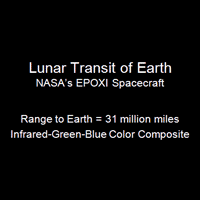EPOXI
Two intriguing investigations -- One flight-proven spacecraft
Gallery
EPOCh Observations:
EPOXI's Spacecraft Observes the Earth-Moon System
Videos of the Moon transiting the Earth, as imaged by NASA's EPOXI spacecraft, were made from the still images collected when EPOXI's spacecraft imaged the Earth-Moon system on 28-29 May 2008. When the images were acquired, the spacecraft was just outside the orbit of the Earth and ahead of Earth by 31 million miles, 1/3 AU, making it as far from Earth as Mercury is from the Sun.
The videos were made by Don J. Lindler (Sigma Space Corporation, at GSFC), working closely with the EPOXI (EPOCh + DIXI) Science Teams. Two versions are available, using different wavelengths for the red channel in the color composites (see discussion below).
 |
nir_green_blue |
 |
red_green_blue |
These color composite videos were constructed from sets of near-simultaneous images in narrow-band (100 nm width) filters. The image sets were obtained at a 15-minute cadence. The telescope "point spread function" was measured using observations of stars, and was deconvolved using the Richardson-Lucy algorithm. The restored images were stretched by raising the intensities to the 0.75 power before display to enhance the lower intensities (e.g., the Moon) without saturating the higher intensities. The red-green-blue video used filters at 650 (red), 550 (green), and 450 (blue) nm, whereas the infrared-green-blue version substituted 850 nm, in lieu of 650 nm. The infrared version shows the presence of vegetation on continents very prominently. This is particularly noticeable in southern Africa, the Amazon basin, and North America. The primary reason is that terrestrial plants reflect sunlight more strongly at wavelengths longer than about 750 nm, so vegetated regions appear brighter at 850 nm. Also, aerosol opacity of clouds and hazes is reduced at longer wavelengths, and that contributes to the greater visibility of Earth's continents in the infrared version. In the red-green-blue video, the most prominent land feature is the Sahara region of North Africa, together with the Arabian peninsula, due to reflectivity of sand. By analogy, when extrasolar terrestrial planets are observed, desert regions may be detectable at red wavelengths, and vegetation using near-infrared wavelengths.
During the videos, the Moon enters the frame from the left and transits across the Earth. The motion of the Moon is due to its orbit around the Earth, and this was known in advance, so the images were specifically timed to capture this event. Note that the Moon appears relatively dark, and slightly reddish, as compared to Earth, very unlike the bright Moon that is familiar to us in the night sky. However, when we view the Moon at night, we are not comparing it to the bright, blue disk of the Earth. The video correctly shows that the Moon is darker and redder than the Earth.
A particularly interesting aspect of the video is the "sun glint" that is due to a specular reflection from the Earth's oceans. The glint does not rotate with features that are fixed on the Earth, and your eye can find it by looking for a slightly brighter spot that stays in almost the same position. Notice that it brightens suddenly near times (UT) 00:50 and 16:05, possibly due to reflection from regions of the ocean that are smoother and less disturbed by wave motion. The glint is polarized, and would become much more prominent by imaging in polarized light. EPOXI has no polarization capability because the instruments were not designed for this application, but advanced missions to image rotating extrasolar terrestrial planets could in principle infer the presence of oceans by observing time variations in polarized light.
Video Credit: Don J. Lindler, Sigma Space Corporation and NASA/JPL-Caltech/GSFC/UMD
Press Release: GSFC 08-068
CREDITS: We extend special thanks to the EPOXI flight team at NASA's Jet Propulsion Laboratory for operation of the spacecraft, for design and implementation of the Earth observing sequences, and for downlink of the data. We also thank Lucy McFadden and Tilak Hewagama (UMD) and Timothy Livengood (USRA), for image deconvolutions and color co-registration on preliminary renderings of the lunar transit data.
The EPOXI "Earthlings" portion of the science team includes:
- Michael A'Hearn (UMD, EPOXI Principal Investigator)
- Sarah Ballard (Harvard)
- David Charbonneau (Harvard, EPOCh Deputy Principal Investigator)
- Jessie Christiansen (Harvard)
- Nicolas Cowan (Univ. Washington)
- Drake Deming (GSFC, EPOCh Principal Investigator)
- Donald Hampton (Univ. Alaska)
- Tilak Hewagama (UMD)
- Matthew Holman (SAO)
- Kenneth Klassen (JPL)
- Marc Kuchner (GSFC)
- Carey Lisse (JHU/APL)
- Timothy Livengood (USRA, Lead Co-I for Earth Observations)
- Lucy McFadden (UMD)
- Victoria Meadows (Univ. Washington)
- Jeffrey Pedelty (GSFC)
- Tyler Robinson (Univ. Washington)
- Alfred Schultz (GSFC)
- Sara Seager (M.I.T.)
- Jessica Sunshine (UMD, DIXI Deputy Principal Investigator)
- Joseph Veverka (Cornell)
- David Welldrake (SAO)
- Dennis Wellnitz (UMD)
Inspired
Questions
- Q: The moon takes 28 days give or take to orbit us, so why does it appear to zip across the face of our planet in just a few hours? It's freakin' cool, but can someone explain that?
- A: We are not seeing the full extent of the orbit. We are just seeing a small portion where it crosses in front of the Earth... Think back to the Mercury Transit or Venus Transit of the sun. Both crossed the face of the sun in only a few hours but take much, much longer to orbit around the sun!
Dr. Tony Farnham has very kindly made a diagram showing the geometry. - Q: Very cool movies. Just wish the resolution was better.
- A: The movie is put together from just a small portion of the actual frame (no need to show alot of empty space!) and of course was taken from 31 million miles away.
